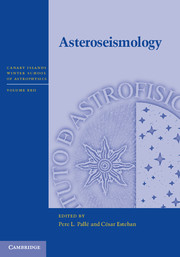Book contents
- Frontmatter
- Contents
- List of contributors
- List of participants
- Preface
- Acknowledgments
- Abbreviations
- 1 Sounding the solar cycle with helioseismology: Implications for asteroseismology
- 2 Learning physics from the stars: It's all in the coefficients
- 3 Solar-like oscillations: An observational perspective
- 4 Studying stars through frequency inversions
- 5 A crash course on data analysis in asteroseismology
- 6 An observer's views and tools
- 7 Asteroseismology of red giants
- References
4 - Studying stars through frequency inversions
Published online by Cambridge University Press: 05 December 2013
- Frontmatter
- Contents
- List of contributors
- List of participants
- Preface
- Acknowledgments
- Abbreviations
- 1 Sounding the solar cycle with helioseismology: Implications for asteroseismology
- 2 Learning physics from the stars: It's all in the coefficients
- 3 Solar-like oscillations: An observational perspective
- 4 Studying stars through frequency inversions
- 5 A crash course on data analysis in asteroseismology
- 6 An observer's views and tools
- 7 Asteroseismology of red giants
- References
Summary
Introduction
Helioseismology, the study of the Sun using solar oscillations, has provided us with the means to probe the solar interior. Since the discovery of the oscillations in 1962 (Leighton et al., 1962) and their interpretation as global oscillation modes by Ulrich (1970) and Leibacher and Stein (1971), helioseismology has been used extensively to study the interior of the Sun, mainly through inversions of solar frequencies. With space missions such as CoRoT (Baglin et al., 2006) and Kepler (Borucki et al., 2010) now observing oscillations of other stars, inversions of stellar frequencies may soon be feasible. There are two ways by which we could use seismic data to make inferences about the stars. The first way involves trying to find models whose frequencies match the observed frequencies, usually referred to as “forward modeling.” This is essentially what is done in most fields of astronomy. The end result of the process is a model that is the best match to the observations. The second way is to invert the data. Inversions use the data directly to make inferences about the star. In the case of inversions, we can make a distinction between the structure of the star and the structure of the best-fit model. These days inversions are used to study the solar interior, while forward modeling is used to study other stars.
It is not possible to do an inverse analysis unless we can do the forward analysis.
- Type
- Chapter
- Information
- Asteroseismology , pp. 87 - 122Publisher: Cambridge University PressPrint publication year: 2014
References
- 2
- Cited by

